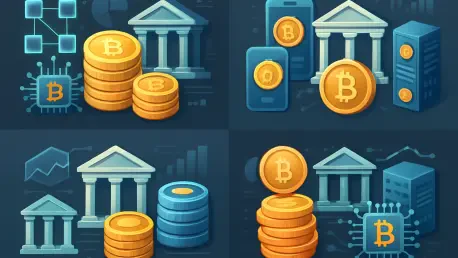In an era where financial systems are under constant pressure to evolve, a seismic shift is unfolding as major global banks embark on a bold journey to integrate blockchain technology into mainstream finance, aiming to revolutionize the industry. This initiative, driven by industry giants like Goldman Sachs, UBS, Citigroup, and others, centers on the creation of reserve-backed digital money on public blockchains, a move that could potentially transform how payments are processed worldwide. Unlike volatile cryptocurrencies or unregulated stablecoins, this new form of digital currency is designed to be backed 1:1 by reserves in G7 currencies, ensuring stability and trust. The implications are vast, promising faster cross-border transactions and reduced friction in international trade. Yet, as this innovation gains momentum, it also raises critical questions about regulation, financial stability, and the future role of traditional banking systems in a rapidly digitizing economy. This development marks a pivotal moment, blending cutting-edge technology with established financial frameworks.
Blockchain’s Role in Modern Banking
Pioneering a Stable Digital Currency
A groundbreaking collaboration among leading financial institutions is setting the stage for a new era in banking with the introduction of reserve-backed digital money. This consortium, comprising heavyweights such as Deutsche Bank, Bank of America, and BNP Paribas, aims to leverage public blockchains to create a payment asset that stands apart from the volatility associated with cryptocurrencies. By ensuring a direct correlation with G7 currency reserves, these banks are crafting a tool that promises reliability and regulatory compliance. The primary goal is to streamline cross-border payments, which often suffer from delays and high costs due to outdated systems. This digital currency could serve as a bridge, connecting traditional finance with the efficiency of blockchain technology, while maintaining the trust that banks have cultivated over decades. Such an approach not only modernizes payment infrastructures but also positions these institutions to remain competitive in an increasingly digital marketplace.
Competing with Non-Bank Stablecoins
The rise of non-bank stablecoins in crypto markets has prompted traditional banks to take decisive action to reclaim control over payment flows. These alternative digital currencies, often issued by tech firms or decentralized entities, have gained significant traction, challenging the dominance of established financial players. In response, the consortium of global banks is focusing on a regulated, reserve-backed alternative that prioritizes stability over speculation. This strategic move is designed to mitigate the risks associated with unregulated digital assets while offering a viable solution for businesses and consumers alike. By utilizing their existing infrastructure and reputation, these banks aim to provide a competitive edge, ensuring that transactions remain secure and compliant with international standards. This initiative reflects a broader trend of adaptation, where traditional finance seeks to integrate innovative technologies without sacrificing the principles of trust and accountability that underpin their operations.
Challenges and Opportunities Ahead
Navigating Regulatory Hurdles
As global banks push forward with reserve-backed digital money, regulatory scrutiny presents a formidable challenge that cannot be overlooked. Central banks and financial authorities, including prominent figures from the Bank of England and the European Central Bank, have voiced significant concerns about the potential impact of digital currencies on monetary policy and financial stability. The fear is that widespread adoption of such innovations could disrupt traditional banking systems, diverting payment flows away from established channels and into uncharted territory. This tension between innovation and oversight underscores the need for a delicate balance, where technological advancement does not come at the expense of systemic security. Banks involved in this initiative must work closely with regulators to address these concerns, ensuring that their blockchain-based solutions align with global standards while still pushing the boundaries of what is possible in finance.
Shaping the Future of Global Transactions
Looking beyond the immediate hurdles, the potential for reserve-backed digital money to reshape global business transactions offers a compelling vision for the financial industry. By harnessing the transparency and efficiency of public blockchains, banks are poised to reduce the friction that plagues international payments, creating a more interconnected and agile economic landscape. This collaborative effort also serves as a model for risk management, as the consortium approach distributes challenges across multiple institutions, fostering broader adoption and resilience. The focus on centralized control within a decentralized framework highlights a unique strategy to balance innovation with security. As this technology matures, it could pave the way for new industry-wide solutions, driving value in the digital asset space and reinforcing the relevance of traditional banks in a rapidly evolving market. This forward-thinking approach suggests a future where blockchain becomes a cornerstone of financial operations worldwide.
Reflecting on a Transformative Shift
The journey of global banks to integrate reserve-backed digital money on public blockchains stands as a defining chapter in the evolution of finance. This ambitious endeavor by a powerful consortium tackles inefficiencies in cross-border payments and challenges the rise of non-bank stablecoins with a regulated alternative. Despite the promise of enhanced stability and widespread adoption, regulatory warnings about potential threats to monetary policy and systemic stability cast a shadow over the initiative’s early progress. The commitment to blockchain technology by these institutions marks a significant milestone, demonstrating a willingness to embrace innovation while navigating complex oversight landscapes. Moving forward, the success of this shift hinges on collaborative dialogue between banks and regulators to craft frameworks that support innovation without compromising security. Additionally, continued investment in blockchain infrastructure and industry partnerships could further solidify this digital currency’s role in global trade, offering a blueprint for future financial transformations.









